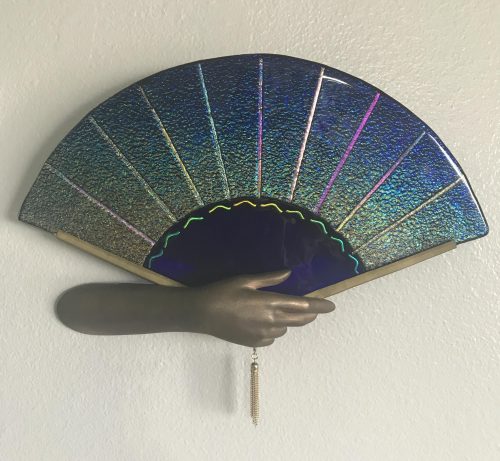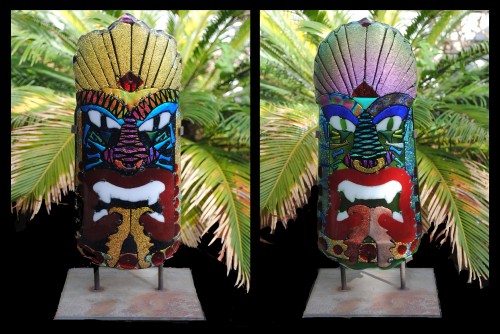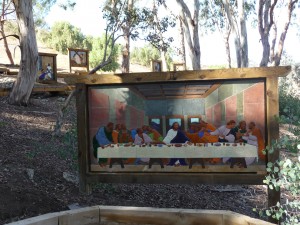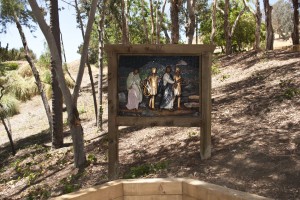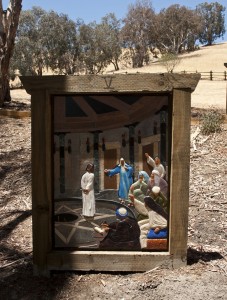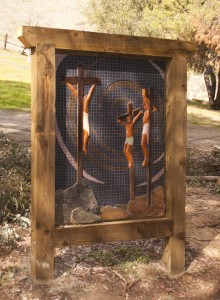Tikis
Tikis on Steel Pedestal:
Lance Jost creates Polynesian Tiki Sculptures of fused and slumped iridescent and translucent glass. Standing alone on a patina’d steel base or back lit on a wall sconce, the beautiful combination of glass and vibrancy offer a striking and unique imagery of the tiki.
“I was fortunate to be in the presence of an incredible collection of primitive masks in La Jolla in 2014,” said Jost, “and was struck by the power of the graphic images. Grained and discolored with age, I thought, “What can I do with this idea to bring it forward and into today’s world?”
Tiki Wall Sconce:
Art Glass
Lance Jost creates Polynesian Tiki Sculptures of fused and slumped iridescent and translucent glass. Standing alone on a patina’d steel base or back lit on a wall sconce, the beautiful combination of glass and vibrancy offer a striking and unique imagery of the tiki.
“I was fortunate to be in the presence of an incredible collection of primitive masks in La Jolla in 2014,” said Jost, “and was struck by the power of the graphic images. Grained and discolored with age, I thought, “What can I do with this idea to bring it forward and into today’s world?”
The 15 Stations of the Cross
I was fortunate to have a film crew from Saddleback Church come to my studio in Dana Point, CA, to film the process of creating one of the 15 Stations of the Cross. Although it’s not the entire process, it gives you a glimpse of what goes into one of my mosaics.
1. Woman Anoints Jesus’ Feet
On the surface, Lance Jost’s concept of “Woman Anoints Jesus’ Feet” looks pretty simple. He depicted Jesus sitting comfortably on a pillow in a pleasant setting with food and wine. He is relaxed and reconciled with His fate, while a woman anoints His feet with oil. Jost included a window to portray the beauty of the sky with leaves coming through to give an airy effect. A dove was added, perched on the window sill, to indicate the presence of the Spirit.
What you don’t see in this station is what was going on peripherally. Wondering whether to include the celebration going on in Simon the Leper’s home, Jost decided instead that the focus should be on the relationship between Jesus and the woman. That moment in time was so special to the pair compared to the disciples’ criticism of the cost of the oil she used and how it should have been sold to feed poor children.
“When writing this particular blog,” said Jost, “I believed at first that not every Station of the Cross was meant to have a message. I really struggled. What was I supposed to get out of “Woman Anoints Jesus’ Feet”?
It began to come together when I read Christ’s response to the disciples’ criticism over the use of the expensive oil. He said, “Leave her alone. She’s giving me a kindness.” This wasn’t a matter of being selfish on Christ’s part. It was about preparing for His death. Christ was aware of His fate and anointing the body was part of the traditional preparation for burial.
Jesus tried to give the disciples a wake-up call that He wasn’t going to be around much longer, but they didn’t catch on. The woman was a close friend, not a hanger-on. She was also a charitable woman who had invested her life in Jesus, practicing the message of love that He taught.
Jesus apparently shared his insights with her because she grasped what was going to happen sooner than the others. In return, the woman honored the fact that He was about to leave this world by anointing His feet with the costly and lavish oil.
I got it! The message from creating “Woman Anoints Jesus’ Feet” finally came to me. It never should have been about the cost of the oil. Neither Jesus nor the woman listened to the disciples because what was happening on the fringe didn’t matter to them. Their focus was solely on the act of kindness the woman showed to Jesus. It was always about her devotion to the Master.”
2. The Last Supper
Now when evening came, Jesus was reclining at the table with the twelve disciples. As they were eating, He said, “Truly I say to you that one of you will betray Me.” Being deeply grieved, they each one began to say to Him, “Surely, not I, Lord?” And He answered, “He who dipped his hand with Me in the bowl is the one who will betray Me. The Son of Man is to go, just as it is written of Him; but woe to that man by whom the Son of Man is betrayed! It would have been good for that man if he had not been born.” And Judas, who was betraying Him, said, “Surely it is not I, Rabbi?” Jesus said to him, “You have said it yourself.”
While they were eating, Jesus took some bread, and after a blessing, He broke it and gave it to the disciples, and said, Take, eat; this is My body.” And when He had taken a cup and given thanks, He gave it to them, saying, “Drink from it, all of you; for this is My blood of the covenant, which is poured out for many for forgiveness of sins. But I say to you, I will not drink of this fruit of the vine from now on until that day when I drink it new with you in My Father’s kingdom.” After singing a hymn, they went out to the Mount of Olives. Matthew 26: 20-30, NASB
When the hour came, Jesus and his apostles reclined at the table. And he said to them, “I have eagerly desired to eat this Passover with you before I suffer. For I tell you, I will not eat it again until it finds fulfillment in the kingdom of God.”
After taking the cup, he gave thanks and said, “Take this and divide it among you. For I tell you I will not drink again from the fruit of the vine until the kingdom of God comes.”
And he took bread, gave thanks and broke it, and gave it to them, saying, “This is my body given for you; do this in remembrance of me.”
In the same way, after the supper, he took the cup, saying, “This cup is the new covenant in my blood, which is poured out for you. But the hand of him who is going to betray me is with mine on the table. The Son of Man will go as it has been decreed. But woe to that man who betrays him!” They began to question among themselves which of them it might be who would do this. Luke 22:14-23, NIV
3. Jesus in the Garden of Gethsemane
Deciding which of the 15 Stations of the Cross to use to begin his journey, Jost found selecting just one was difficult. Many of the images seemed so daunting, except for one; Jesus in the Garden of Gethsemane. Jost immediately got in touch with this particular image because its message mimicked exactly what he does. “Jesus in the Garden of Gethsemane pours out his heart to the Father, recognizing what he is about to endure,” says Jost. “I also pray for guidance, strength, and an understanding of what I’m supposed to be doing here on Earth.”
Jost always felt he had a more specific message for those who hadn’t discovered a reason to invest their faith in God. Inspired by II Timothy 2:15: Study to show thyself approved unto God a workman that needs not to be ashamed rightly dividing the Word of Truth; Jost has a great respect for those who question their understanding of the Bible. “It’s important to have your own faith, not just buy into someone else’s,” Jost added.
4. Jesus is Betrayed by Judas and Arrested
While Jesus was still speaking, Judas, one of the Twelve, arrived, accompanied by a crowd with swords and clubs, who had come from the chief priests, the scribes, and the elders. His betrayer had arranged a signal with them, saying, “the man I shall kiss is the one; arrest him and lead him away securely.” He came and immediately went over to him and said, “Rabbi.” And he kissed him. At this they laid hands on him and arrested him. Mark 14: 43-46
5. Jesus is Condemned by the Sanhedrin
When day came the council of elders of the people met, both chief priests and scribes, and they brought him before their Sanhedrin. They said, “If you are the Messiah, tell us,” but he replied to them, “If I tell you, you will not believe, and if I question, you will not respond. But from this time on the Son of Man will be seated at the right hand of the power of God.” They all asked, “Are you then the Son of God?” He replied to them, “You say that I am.” Then they said, “What further need have we for testimony? We have heard it from his own mouth.” Luke 22: 66-71
6. Jesus is Denied by Peter
In “Jesus is Denied by Peter,” Lance Jost’s idea was to catch Peter at the exact moment when he recalled Christ’s words, “Before the cock crows, you will deny me three times.”
“I’m your guy,” Peter reassured Jesus. “I’m in there with you to the end.”
However, when Jesus was roughed up and abruptly arrested in the midst of His disciples, Peter panicked, thinking he would be taken away as well. He basically did what he had to do to save his own skin.
“This is a pretty poignant instance to make the point of Peter’s denial,” said Jost. “It’s a definitive moment in his story.”
To depict the city walls in “Jesus is Denied by Peter,” Jost again used cut blocks of stone as well as cobblestone streets to keep in line with the authenticity of the times. He cast the fire pit where Peter warmed himself out of fused glass with oranges and iridescent pieces to make it look like glowing hot coals. Jost then cast brightly colored and black iridescent glass for the cock’s feathers. All of the figures were sculpted and cast in glass as well. However, he glazed the warrior’s armor in gold to give it a metallic quality that would stand out.
“Jesus dealt with each of His disciples according to their own personalities,” said Jost. “Peter was possibly His closest disciple with whom He shared special insights, including the fact that when things got tough, Peter would deny even knowing Him.
It would be very easy to get the same cheap shot out of this station’s meaning, which is to hammer people with guilt. But I don’t like using Bible stories out of context that don’t have anything to do with the real message.
The real lesson here is that even as flawed as Peter was—giving into pressure when the chips were down—Jesus would still use him as the primary purveyor of His message after His death.
Jesus said to Peter, “You are my rock, and on this rock I will build my church.”
So the message of “Jesus is Denied by Peter” isn’t the guilt of his failure. That’s negating the freedom and the beauty of forgiveness that Christ offered us by dying on the cross. The lesson here is that knowing how weak Peter was, He still counted on him to come through.
Applying this to our lives as believers, even with all of our flaws, God can use us if we have faith and realize we can overcome our weaknesses.”
7. Jesus is Judged by Pontius Pilate
In Lance Jost’s three previous stations the settings were in a garden or outdoors. To depict the scene of “Jesus is Judged by Pontius Pilate,” he needed to place Christ in the opposite; a richly appointed interior scene that would belie the wealth and power of Pilate. The restriction of Christ bound, and intimidated by the prefect of Judaea’s power was heavily amplified by being in his palace.
“Pilate was a wealthy guy,” said Jost. “His home was constructed with marble and the finest polished stone. It was necessary to portray this scenario so that the viewer could experience just what Jesus must have been feeling on deck, front and center while being scrutinized.”
Aside from the marble column and the high-quality stone to show Pilate’s wealth, Jost cast Jesus to show a man of poorer stature, while his use of gold glazed throughout Pilate’s laurel wreath and arm band was meant to imply his importance over Christ.
“Pontius Pilate was very curious to meet this Jesus “fellow” that he had heard so much about,” said Jost. “He had no personal grind with Him. His interest was in keeping the peace so that the taxes could keep flowing into Rome. That was his job.
However, when the rumble of Jesus being the Son of the Jews flew in the face of Pilate’s allegiance to Caesar, who was the ruler of the world, this was totally over the top. Caesar was revered as God, along with their pantheon of Gods.
Riding through Jerusalem’s gates on two white donkeys on Passover was Christ’s ploy designed to enrage the temple priests with an auspicious display of public grandstanding. But Pilate saw no fault in Him. Christ had violated no Roman laws. To appease his own conscience for condemning an innocent man, Pilate offered to free Him in keeping with an annual tradition of amnesty.
The Jews were inflamed by this offering. Barabbas, a zealot who organized assassins against the Roman occupation of Israel, was more in keeping with their passion to liberate God’s people from Rome.
Although the Jews saw no value in Christ’s message of love, in the act of His giving up and offering Himself to be sacrificed, His message of kindness, and ultimately love, would be forever planted in the heart of Rome. Not to defeat it, but to fulfill it and thereby liberate the Jews.
It was like winning without firing a shot.”
8. Jesus is Scourged at the Pillar and Crowned with Thorns
The setting Lance Jost wanted to portray in “Jesus is Scourged at the Pillar and Crowned with Thorns,” is one of pain and abandonment. Standing alone, bound and bleeding, Jesus is surrounded by the beauty of the Praetorium and the window, a gateway to freedom. Enduring the humiliation of being dressed and treated as the “King of the Jews,” then repeatedly whipped, slapped in the face, and spat on, Jesus is most assuredly at one of His lowest points. He has no control over His situation, and no one on His side save the Father in Heaven. But His time had not come yet.
Jost depicted the grandness of the palace by using marble for the pillars, and cut stone for the walls and floors. Ceramic tile was again utilized for the sky and foliage. Christ and his crown of thorns were sculpted out of clay then cast in glass, His robe created from purple glass. The rope wrapped around Jesus was cast into the mold.
“It’s difficult to believe that the message behind “Jesus is Scourged at the Pillar and Crowned with Thorns” is about love,” said Jost. “Your first guess might be that the meaning here is abandonment. Everything Jesus went through, he did it alone with no one by his side.
But think about it. He had long ago resigned himself to the fact that His death was necessary to atone for the sins of humanity. He knew going in that this would be a frightening experience. He also braved the pain of the lashings, the mockery of being struck and spat on by the soldiers, and even survived the humiliation of being hailed as the “King of the Jews.” So how can this possibly be interpreted as love?
Nearing His final hour, after all the sacrifices Jesus made for us, as well as His willingness to help orchestrate His own death; through all the degradation He tolerated, He did this because of His love for the Father and for us.”
9. Jesus Bears the Cross
Intimidated at first to create stations that would need to be articulated so closely, Lance Jost settled on one that would be better depicted from a respectable distance. The theme of “Jesus Dies on the Cross,” however, was about His death. Because painting futility and frustration was also difficult for Jost to conceive, he felt it was important to make something beautiful out of this particular scene.
Jost wanted the theme of this mosaic to be not just about Jesus dying on the cross, he wanted to show the relationship between that dire event and the people and the village below. “It’s the relationship that matters most,” said Jost.
The most important historical aspect to get right for Jost was the crucifixion mount, or Golgotha, which means the place of the skull. Located on the side of a hill outside the City gates of Jerusalem, Jost needed this natural foundation to be dramatic and stark, with nothing pretty about it.
With each station, Jost was discovering new techniques to convey the meaning of his work. Although it was challenging to replicate the sun as it was coming out of the eclipse, he figured out how to create clouds in a dark sky with just a bit of light peeking through.
While working on his Journey with Jesus, Jost was also growing emotionally.
“Through our lifetime we have to learn to take our physical bodies quite seriously,” said Jost. “We must feed it, clean it, strengthen it, and clothe it. We are so involved that we begin to take pride in it. At some point we attach our ego so that finally we think that our body is us.”
Pop that bubble! We must remember that our physical body is only a soul carrier and in the big picture, nothing important enough to cling to so that we fear to leave it.
“As much as Christ knew who he was,” adds Jost, “the reality of leaving his body was still a terrifying experience for Him. However, our bodies are transitory. Eternity is what we’re really looking forward to without the present limitations of our physical body. We’re empowered beyond our imagination once we’re set free.”
10. Jesus is Helped by Simon the Cyrenian to Carry the Cross
In Lance Jost’s portrayal of “Jesus is Helped by Simon the Cyrenian to Carry the Cross,” his chosen focus was that of one man helping another. Jost depicted Jesus a broken body. Bleeding and hunched over from the weight of His circumstances, you can see how He struggled. Simon the Cyrenian is close behind Jesus, helping to alleviate some of His pain. In contrast, the soldier hovers nearby in command, with a close watch on the two men as they make their way through the streets of Jerusalem and past the temple.
“Jesus is Helped by Simon the Cyrenian to Carry the Cross” is another station that took place in the city streets of Jerusalem. The placement of sandstone paves Christ’s way, the city walls cut from stone tiles direct him to Golgotha. The temple, which sits upon the darker stone of the hillside, was created from cast glass and signifies the relationship between it and Jesus. Metallic armor represents the soldier’s power, and reclaimed and weathered wood that was impregnated with resin for preservation, was used for the cross to show the weight of Christ’s burden.
“Visually, this station seems easily explained,” said Jost. “Exhausted, after enduring so much pain, Jesus is assisted by Simon as He carries the heavy cross to His crucifixion. Why not help Christ with those last few steps? It would be the compassionate thing to do.
But there’s a little twist here. This image isn’t exactly what it seems. Simon didn’t volunteer to help Christ, nor did Jesus ask for Simon’s assistance. Who then?
The least likely person, the Roman soldier, pulled Simon off the street and ordered him to help Jesus. As stated in Mark 15:21, “They compelled a passerby, who was coming in from the country, to carry His cross; it was Simon of Cyrene, the father of Alexander and Rufus.”
Now, there are a number of reasons why the soldier could have shown this act of mercy. Was it out of sorrow? Did he witness Pilate’s hesitance to convict Jesus? Or maybe it was traditional to assist those who had been beaten down and sentenced to death.
Whatever the motive, they all point to compassion. So what can we learn from the Roman soldier’s act of mercy, especially after everything he and the others had inflicted upon Christ? It’s simple. You just never know when or where kindness will come to you. Most likely, your friends and family help when you’re in need or maybe a stranger does something nice out of the blue. The least expectant is when you receive an act of kindness from those you thought were your enemies. Better yet, by us reaching out with compassion, we, in turn, become Christ-like.”
11. Jesus is Crucified
In “Jesus is Crucified,” Lance Jost wanted to show the figure of Christ alone on the cross because this was His time. Even though He was flanked by the two thieves, He felt forsaken by the Father and had to walk that lonesome valley by Himself.
In Jost’s depiction of the sky, rather than make it pretty, he portrayed it much more dramatic; using gray swooping clouds to emphasize the dimension of the landscape.
Jost took special care to sculpt the figure of Christ in this mosaic. The others he had done were pictured in a more distant fashion, either from a side or back view, which didn’t require such articulation. But in “Jesus is Crucified,” which is a frontal view, he had to pay much closer attention to the finer details.
As in previous stations, the cross is crafted out of aged oak, the sky from ceramic tile; cut, stained glass was utilized for the clouds, and rocks and sand were impregnated into cement to depict the ground.
“Though God knows everything, and Christ is God,” said Jost, “I don’t feel that it gave Him much comfort at this moment. Things only got worse when He realized He was dying. Christ had been in His body for about 30 years and at this point, after that amount of time, one tends to take it quite seriously. Even though He knew He had to leave it, it was still pretty spooky to realize you’re about to give it up.
His inner understanding and relationship with the Father notwithstanding, Christ was tempted as we are all tempted. I believe that He had to experience all these things in the same way we do. He had serious doubts and fears about what was going to happen. “Will I really have life after death?” He might have thought.
The shock and disorienting pain He suffered from being beaten and pierced must have made it intensely difficult to reason clearly. He knew who He was and what He had to do, however, He had to dig deep to reason and pray it out like we do to find our way at our crosses.
We are assured in Hebrews 4:15 that He is not above us so that He can’t sympathize with our weaknesses, but “One who has been tempted in all things as we are.””
12. Jesus Promises His Kingdom to the Good Thief
Lance Jost’s focus in “Jesus Promises His Kingdom to the Good Thief” was solely on the relationship and interaction between Christ and the two thieves crucified with him.
However, the concept was as much about position. Jost intentionally placed Jesus and the Good Thief on the right side of the mosaic and facing each other to represent the positive communication between the two, as the latter reaches out to Christ for forgiveness. Notice the third thief is off to the left, forlorn and by himself, going on about how they all deserved their imminent death sentence.
Also by placing Christ and the Good Thief smaller versus the larger thief in the forefront, Jost doesn’t diminish the strength of their solidarity, but emphasizes it.
Lastly, instead of using clouds and the sky to portray the overall beauty of the day, the artist stuck to darker tones to bring out the forceful energy swirling around the dynamic of the situation.
Jost depicted the energy encompassing the three sculpted figures with muted grays, tans, and mauves against the darker gray of the sky, which represents the looming full eclipse.
The three crosses were created with reclaimed oak, the sky out of ceramic tile, and sand impregnated in cement along with sandstone were utilized at the bottom of the mosaic.
“In his hour of darkness, the thief on the left can only dwell on the fatality of their inequities,” said Jost. “His sole focus is on guilt. But the Good Thief reached out and was pardoned the moment he accepted Christ’s forgiveness. In Luke 6:37, it states, “Do not judge, and you will not be judged; and do not condemn, and you will not be condemned; pardon, and you will be pardoned.”
An even stronger example of this is Mark 11:26, which states, “But if you do not forgive, neither will your Father who is in heaven forgive your transgressions.”
This is what we need to do in our daily lives. We have to reach out for forgiveness before we can accept it. In the act of reaching out for help, we are empowering ourselves to receive it.
Christ loves to forgive. In this moment he was intensely immersed in orchestrating his own death in order to be the sacrificial lamb to atone for the sins of humanity. That’s what I like about the Big Guy so much. In the middle of all his suffering, he still had the awareness to teach us another lesson, about the empowerment and freedom that we receive in our act of forgiveness. We can’t keep carrying the burden of anger toward others. If we really want to be set free, we need to forgive in order to leave the door open to maintain healthy relationships.
Forgiveness is really a gift to ourselves.”
13. Jesus Dies on the Cross
Intimidated at first to create stations that would need to be articulated so closely, Lance Jost settled on one that would be better depicted from a respectable distance. The theme of “Jesus Dies on the Cross,” however, was about His death. Because painting futility and frustration was also difficult for Jost to conceive, he felt it was important to make something beautiful out of this particular scene.
The most important historical aspect to get right for Jost was the crucifixion mount, or Golgotha, which means the place of the skull. Located on the side of a hill outside the City gates of Jerusalem, Jost needed this natural foundation to be dramatic and stark, with nothing pretty about it.
With each station, Jost was discovering new techniques to convey the meaning of his work. Although it was challenging to replicate the sun as it was coming out of the eclipse, he figured out how to create clouds in a dark sky with just a bit of light peeking through.
While working on his Journey with Jesus, Jost was also growing emotionally.
“Through our lifetime we have to learn to take our physical bodies quite seriously,” said Jost. “We must feed it, clean it, strengthen it, and clothe it. We are so involved that we begin to take pride in it. At some point we attach our ego so that finally we think that our body is us.”
Pop that bubble! We must remember that our physical body is only a soul carrier and in the big picture, nothing important enough to cling to so that we fear to leave it.
“As much as Christ knew who he was,” adds Jost, “the reality of leaving his body was still a terrifying experience for Him. However, our bodies are transitory. Eternity is what we’re really looking forward to without the present limitations of our physical body. We’re empowered beyond our imagination once we’re set free.”
14. Jesus is Placed in the Tomb
Approaching “Jesus is Placed in the Tomb,” Lance Jost wanted to evoke the feeling of being confined in an enclosure. He wanted to depict a somber setting with the viewer inside of the tomb, seeing only a glimpse of the open and airy garden outside of the tomb. The positioning of Joseph of Arimathea and Nicodemus bending down and struggling with the weight of Jesus’ lifeless body belies the oppressive task they chose in devotion to the master.
Jost also wanted to show a freshly built, luxurious tomb as it would be for an esteemed member of the Sanhedrin and a man of means like his uncle, Joseph.
Jost used dark stone to show the interior walls of the tomb. The carved figures were again cast in glass. Ceramic tile was used to create the color of the sky and foliage showing life still going an outside the tomb. Stone tiles were cut to shape to give the floor the illusion of diminishing linear perspective.
“That the Messiah would be killed as an outcast and sinner, but buried as a rich man, was foretold in Isaiah 53:9,” said Jost. “Perhaps this specific prophesy being fulfilled in Christ is designed as part of the divine orchestration, intended to help give faith to such an extraordinary event as a dead man, Jesus, coming back to life.”
15. Resurrection
Approaching the “Resurrection,” the 15th Station of the Cross, Lance Jost created it from the perspective of looking out through the doorway of Jesus’ tomb. The stone covering the opening now rolled away, Jost set the scene with Mary at Jesus’ feet, astonished at finding Him alive. The best way to convey the “Resurrection,” Jost felt, was to contrast the finality of His situation from inside the cavernous tomb against the freedom of His rebirth.
Selecting large dark stones for the interior, Jost laid flat limestone out in perspective to create the illusion of the floor, then draped Jesus’ white robe over the burial slab in sculpted cast glass.
Just outside the rolling doorway, which was carved out of a large flat piece of slate, Jost portrayed Jesus and Mary walking along a trail of colored sand that is aligned with stones and brightly colored cast glass shrubs. Leading the eye out into the world, the pair are also sculpted and cast in glass, and set against the backdrop of a welcoming blue glass tile sky, with the reminder of His crucifixion in the distance.
“Christ being delivered to us in a unique fashion and subsequently resurrected is a difficult concept to grasp,” said Jost. “While there are other examples in the Bible, for instance when Ezekiel comes and goes through the assistance of angels, all are equally astounding. We just don’t see this happening every day.”
Christ was known for occasionally making surprising suggestions during his life; that he was not of this Earth, and that he would tear down the temple and rebuild it in three days.
“Jesus meant that His body was God’s temple on Earth,” adds Jost, “and through his death and resurrection this prediction came true. By planning his own death, Jesus overcame Caesar’s persecution of Christians, and planted the seed of His truth into their hearts, which caused Rome to become the seat of Christianity.
Although we weren’t around to witness His actions, we can now see the power of His impact on the world. He taught us how to live through His words, and that when we implement His principles into our lives we find the peace that passes understanding.
The most amazing thing of all is that He knew this all along.”





